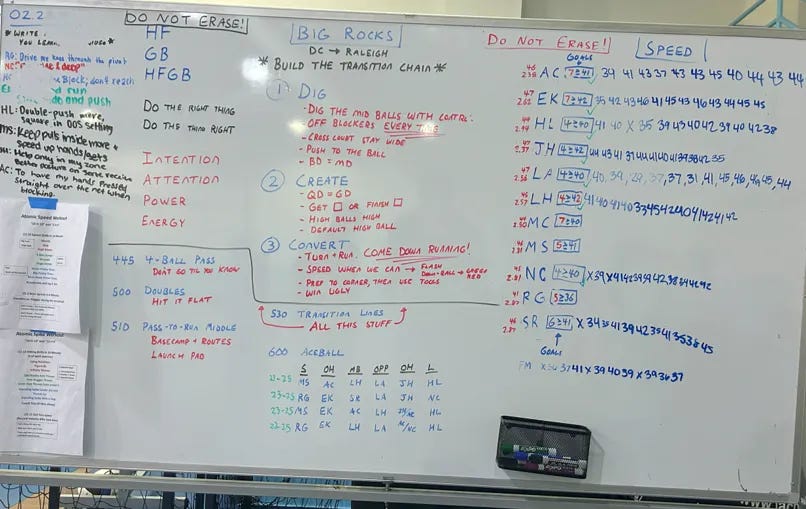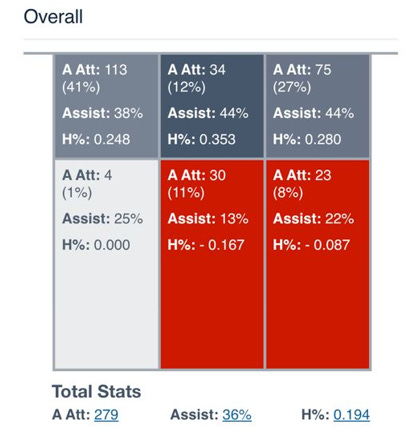Previously:
July Media Wrap
June Media Wrap
May Media Wrap
I’ve been posting some really detailed stuff lately, so this post will be a bit more of a grab-bag.
I’ve been enjoying Loren Anderson’s Substacks. At some point I’ll have a more detailed post about all the things I disagree with in his series about the Youth Sports Industrial Complex. But for now, I’m appreciating him sharing his thoughts on that. A more practical article for coaches that I liked was his 3 Games, 1000 Practices post. That’s very similar to how I plan practice and in fact the whole season. 2v2 (with a split-court), 4v4 (in a square), and 6v6 are also my core setups. I tend to think of those in terms of reps and the Geometry of Practice. If you read The First 12 Practices, you’ll see that there’s basically a similar template to every practice based off similar setups. This allows you to spend a little less time explaining drills and more time teaching.
Carl Hendrick is an education researcher who shares some great stuff about how kids learn. A couple big takeaways:
If I was to sum up his work in one idea, it’s that clarity beats novelty, and that students learn by actually thinking hard about stuff, not merely being entertained.
Carl used to share a coach from George Leonard at GMS clinics:
The essence of boredom is to be found in the obsessive search for novelty. Satisfaction lies in mindful repetition, the discovery of endless richness in subtle variations on familiar themes.
Clarity > Novelty. That might be my new Simple > Complex.
Another takeaway is:
Text combined with diagrams emerged as the most reliable approach across all learning outcomes. This humble combination consistently produced meaningful learning gains whether students were trying to memorise facts, make inferences, or transfer knowledge to new situations.
This was a reminder to me that, if I’m going to discuss something in the huddle before practice, I should have some written reminders on the whiteboard. I almost always link to video examples when I discuss things pre-practice. I generally have discussion points on the board:
But you can never be too clear and be too good at making it clear to kids what they need to learn at practice that day.
For more on that, there’s The Transient Information Effect.
I have a backlog of volleyball podcasts I need to catch up on. I did listen to the CYBO episode on Player Buy-In. Two great takeaways were:
“Have you considered the…”
I’ve heard them say that before and have used that sentence as well. Rather directly get right to, “you should do it this way,” or even, “what do you think about doing it this way?” just cracking the door a little with, “have you seen it done this way?”
Another one was:
Beware of “you’re right.” Look for “that’s right.”
That hit home to me. I’ve taken the Hugh McCutcheon line that, “we’re sales agents first,” but sometimes you can get a player to say, “you’re right,” while not really believing it. It reminds me of a book I listened to about negotiating (I think it was Never Split The Difference) that said basically one of the most important things you can do in a negotiation is to get the other person to say no. Allowing them to define some boundaries gives them a feeling of control. Pushing too hard for, “you’re right,” still makes it my choice as a coach, rather than their decision is a player. Compliance is better than defiance, but you won’t get somebody’s best that way.
Thoughts From The Road
I’m traveling from North Carolina to Nebraska with my wife and daughter for Season 5 of Athletes Unlimited. I love the slightly-silly modified Queen of the Beach format. I like getting to know new players coming from all sorts of different backgrounds, programs, countries, etc. I’m already looking forward to asking some setters, “what do you like to think about in setter tutor,” or asking passers what they’ve found most/least helpful from previous coaches.
Some other thoughts we’ve had on the road:
You can never Check For Understanding too much. Club kids are in their high school season now, so as a club coach (starting a new club!) you hear the highs and lows of high school season, and you hear plenty of complaining about what’s going on at high school programs. A lot of it can be simplified to, “I don’t understand why we’re doing X and it must be because Coach Is Dumb/Hates Me.” I’m exaggerating a bit. And sometimes, maybe I disagree with what that coach is doing. But often, it’s not that dumb. It might be different than what I’d do, but that coach usually has a reason for doing it. The problem is… that reasons hasn’t been shared with the players. That leaves all sorts of room for misunderstanding. When in doubt, Check For Understanding.
Your left-side attacking is the most important determinant in success at the high school/club level. However, your setting might be the most influential factor in how your roster gets put together. As my wife and I talk in the car, we’re discussing what we want to do in the upcoming season, who is going to play where, etc. A lot of that is based off questions like, “what are the strengths and weaknesses of our setter(s)? what can they do? What do they need to learn?,” etc.
At the same time, setting is also a position where you can go down endless rabbit holes that may or may not influence success. Setting might be the number one position where minutia can be discussed to an endless point of no resolution. Or maybe that’s just when you’re married to a setter… :)
I’ve been enjoying the feedback from the discussion on different serving setups. I’ll have a follow up on that soon.
After a summer of doing clinics, Pass-to-Attack footwork remains one of the most controversial things that I teach. Lots of people just love shuffling. I reminds me that There Are No Blank Slates. For whatever reason, a lot of volleyball players have internalized that Shuffling Is Correct. “If I don’t shuffle outside the court, I’m doing it wrong. If this guy doesn’t teach me to shuffle outside the court, he must be teaching it wrong.” I notice this is especially true for girls, who tend to start volleyball earlier than boys. Because little kids have a limited ability to truly play the game, little kid volleyball practices are ripe for over-teaching Fake Fundamentals. This has lasting effects. Also: this is why I think there’s an important place for Direct Instruction when teaching young athletes — there are times when they will come into your gym with a less-ideal prior about how to execute a play and you need to directly replace that concept with a better one.
Back-row attacking is an important piece of high-level play. For everybody below the elite level (and almost all of women’s NCAA is still here) ruthlessly eliminating the back-row attack is a quick and easy way to upgrade your offense. A high school coached shared this with me as they prepared for a match against a strong opponent:
This team is hitting about 0.200 overall, but they are negative out of the back-row. And yet, they are setting 20% of their offense to the back-row! This team is setting more back-row than they are middle. Sure, sometimes you’re in a scramble situation and getting a back-row attack might be better than sending a freeball. But for this team they would be better off sending a freeball! Don’t keep doing something that’s worse than sending a freeball!
This plagues NCAA teams as well. It’s almost a kiss of death… one pipe scores early in the match and that team keeps going back to it. You’re usually better off forcing the ball to the front-row than resorting to the pipe and you’re almost always better off setting the middle instead of the pipe. Outside of the top-25, I think just not having the pipe as part of your non-emergency offense is better for most teams. I think most teams would be better off replacing the training time they spend on the pipe with trying to find the middle from off the net and/or in different transition situations.
Looking forward to updating everybody on the Athletes Unlimited season. Stay tuned for more Match Breakdowns — both finishing up Women’s Worlds as well as the Men’s field as they finish out — as well as more additions to the SmarterVolley Systems series that is proving to be prettypopular.


